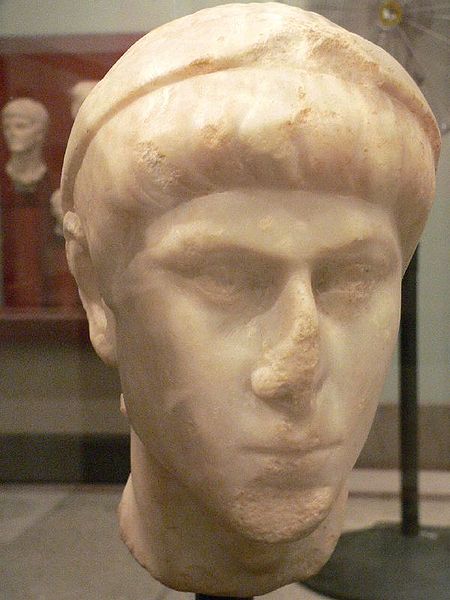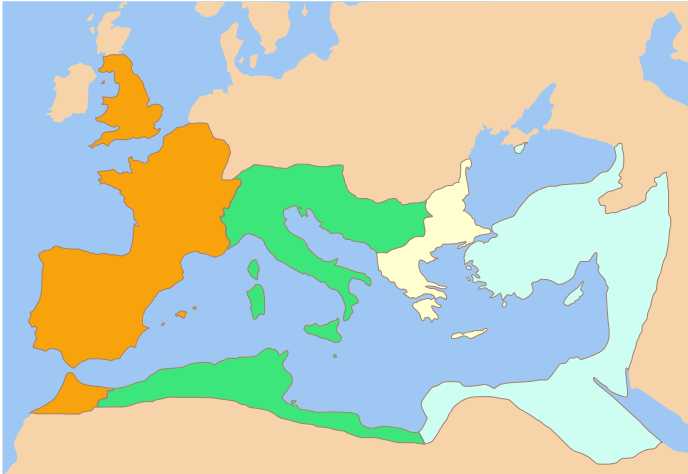<Back to Index>
- Geographer Carl Ritter, 1779
- Poet Alonso de Ercilla y Zúñiga, 1533
- Emperor of the Roman Empire Flavius Iulius Constantius, 317


Flavius Iulius Constantius, known in English as Constantius II (August 7, 317 – November 3, 361) was a Roman Emperor (337-361) of the Constantinian dynasty.
Flavius Iulius Constantius was born at Sirmium (now Sremska Mitrovica in Serbia) in the province of Pannonia, the third son of Constantine the Great, and second by his second wife Fausta, the daughter of Maximian. Constantius was made Caesar by his father on 13 November 324.
When the elder Constantine I died at Constantinople on 22 May 337, Constantius was the nearest of his sons to that city, and despite being on campaign in the eastern provinces, immediately returned to the city to oversee his father's funeral.
The role of Constantius in the massacre of his relatives (those descended from the second marriage of his paternal grandfather Constantius Chlorus and Theodora) is unclear. Zosimus, writing 498-518 claims that Constantius “caused” the soldiers to murder his relatives, as opposed to actually ordering the action. Eutropius, writing between 350 and 370, writes that Constantius merely sanctioned “the act, rather than commanding it”. However, it must be noted that both of these sources are hostile to Constantius - Zosimus being a pagan, Eutropius a friend of Julian, Constantius’ cousin and, ultimately, his enemy. Whatever the case, Constantius himself, his older brother Constantine II, his younger brother Constans and three cousins, Gallus, his half-brother Julian and Nepotianus, son of Eutropia, were left as the only surviving males related to Constantine. Meeting
at Sirmium not long after the massacre, the three brothers proceeded to
divide the Roman Empire among them, according to their father's will.
Constantine II received Britannia, Gaul and Hispania; Constans (initially under the supervision of Constantine II) Italia, Africa, Illyricum, Thrace, Macedon and Achaea; and Constantius the East. There
are few details of the early years of Constantius' sole reign in the
East. He seems to have spent most of his time defending the eastern
border against invasions by the aggressive Sassanid Empire under Shapur II. These conflicts seem to have been mainly limited to Sassanid sieges of the various fortresses (Nisibis, Singara, Constantia and Amida) of Roman Mesopotamia, which achieved little for either side. Although Shapur II seems to have been victorious in most of the confrontations - except the Battle of Narasara, where one of Shapur II's brothers, Narses, was killed - the overall result must be considered a victory for Constantius because Shapur failed to make any significant gains. In the meantime, Constantine II's desire to retain control of Constans' realm had lead Constantius' two surviving brothers into open conflict; resulting in the death of the elder in 340.
As a result, Constans took control of his deceased elder brother’s
realms and became sole ruler of the Western two-thirds of the Empire.
This division lasted until 350, when Constans was killed in battle by
forces loyal to the usurper Magnentius. This new state of affairs proved unacceptable to Constantius, who felt that, as the only surviving son of Constantine the Great, the position of Emperor was his alone.
As such, he determined to march west to enforce his claims. However,
feeling that the east still required some sort of imperial control, he
elevated his cousin Constantius Gallus to Caesar of the East. As an extra measure to ensure the loyalty of his cousin, he married the elder of his two sisters, Constantina, to Gallus. Before facing Magnentius, Constantius first came to terms with Vetranio,
a loyal Constantian general, who had previously accepted the position
of Augustus in order to retain the loyalty of his troops, and probably
to stop Magnentius from gaining more support. This action may have been
carried out at the urging of Constantius’ own sister, Constantina, who had since traveled east to marry Gallus. Constantius for his own part had previously sent Vetranio the imperial diadem and acknowledged the general‘s new position. However, when Constantius arrived, Vetranio willingly and gladly resigned his position and accepted Constantius’ offer of a comfortable retirement in Bithynia. The following year, Constantius finally met Magnentius in the Battle of Mursa Major,
one of the bloodiest battles in Roman history. The result was a defeat
for the usurper, who withdrew back to his Gaulish domains. As a result,
the cities of Italy switched their allegiance to Constantius and ejected all of Magnentius’ garrisons. Constantius spent the early months of 352 on a campaign against the Sarmatians, before moving on to invade Italy. When Constantius and Magnentius finally met again, at the Battle of Mons Seleucus in southern Gaul, Constantius once again emerged the victor. Soon after, Magnentius, realising the futility of continuing his revolt, committed suicide on 10 August 353.
Constantius spent much of the rest of 353 and early 354 on campaign against the Alemanni on
the Danubian borders. The exact details of this campaign are uncertain,
though it seems to have ended with victory for Constantius. In the meantime, Constantius had been receiving some disturbing reports regarding the actions of his cousin, Gallus. Possibly as a result of these reports, Constantius concluded a peace with the Alemanni, and withdrew to Milan. Once there, he decided to first call Ursicinus, Gallus’ magister equitum, to Milan for reasons that remain unclear. Constantius then requested the presence of Gallus and Constantina. Although at first Gallus and Constantina complied with this order, when Constantina died in Bithynia, Gallus began
to hesitate. However, after some convincing by one of Constantius’
agents, Gallus continued his journey west, passing through Constantinople and Thrace to Petobio in the province of Noricum. It was there that Gallus was arrested by the soldiers of Constantius under the command of Barbatio. He was then moved to Pola, and interrogated. Once there, Gallus claimed that it was Constantina who
was to blame for all the trouble that had been caused while he was in
charge of the east. Apparently, at first, this so greatly angered
Constantius that he immediately ordered the death of Gallus. However, soon after, he changed his mind, and recanted his execution order. Unfortunately for Gallus, this order was delayed by Eusebius, one of Constantius‘ eunuchs, and, as a result, Gallus was executed. On 11 August 355, the magister militum Claudius Silvanus revolted in Gaul. Silvanus had surrendered to Constantius after the battle of Mursa Major.
Constantius had made him magister militum in 353, with the purpose of
blocking the German threats, a feat that Silvanus achieved by bribing
the German tribes with the money he had collected. A plot organized by
members of Constantius' court led the emperor to recall Silvanus. After
Silvanus revolted, he received a letter by Constantius that recalled
him to Milan, but which made no reference to the revolt. Ursicinus, who was meant to replace Silvanus, bribed some troops, and Silvanus was killed. Constantius spent the next few years overseeing affairs in the western part of the Empire primarily from his base at Milan. However, he also visited Rome - for the first and only time in his life - in 357, and, in that same year, he forced Sarmatian and Quadi invaders out of Pannonia and Moesia Inferior, then led a successful campaign across the Danube against the Sarmatians and the Germanic Quadi tribe. Around 357/8, Constantius received ambassadors from Shapur II, who demanded that Constantius restore the lands surrendered byNarseh. Despite rejecting these terms, Constantius still tried to avert war with the Sassanid Empire by sending two embassies to Shapur II. As a result of Constantius' rejection of his terms, Shapur II launched another invasion of Roman Mesopotamia. When news reached Constantius that Shapur II had not only invaded Roman territory, but taken Amida, destroyed Singara and taken Bezabde he decided to return there to face this re-emergent threat in 360. In the meantime, Julian had won some victories against the Alemanni tribe, who had once again invaded Roman Gaul. As such, Constantius requested reinforcements from Julian for his own campaign against Shapur II. However, when he requested reinforcements from Julian’s Gaulish army, the Gaulish legions revolted and proclaimed Julian Augustus. On account of the immediate Sassanid threat, Constantius was unable to
directly respond to his cousin’s usurpation other than by sending
missives by which he tried to convince Julian to resign the title of
Augustus and be satisfied with that of Caesar. By 361, Constantius saw no alternative but to face the usurper with violent force; and yet the threat of the Sassanids remained. Constantius had already spent part of early 361 unsuccessfully attempting to take the fortress of Bezabde. After a time, he had withdrawn to Antioch to regroup, and prepare for a confrontation with Shapur II. However, as it turned out, the campaigns of the previous year had inflicted such heavy losses on the Sassanids that
they did not attempt another round of engagements in 361. This allowed
Constantius to turn his full attention to facing the usurpation of Julian. As such, Constantius immediately gathered his forces and set off west. However, by the time he reached Mopsuestia in Cilicia, it was clear that he was fatally ill and would not survive to face Julian. Apparently, realising his death was near, Constantius had himself baptised by Euzoius, the Semi-Arian bishop of Antioch, and then declared that Julian was his rightful successor. Constantius II died of fever on 3 November 361.
However,
Constantius realised that too many threats still faced the Empire, and
he could not possibly handle all of them by himself, so on 6 November
355, he elevated his last remaining relative, Julian, to the rank of Caesar. A few days later, Julian was married to Helena, the last surviving sister of Constantius. Not long after Constantius sent Julian off to Gaul.